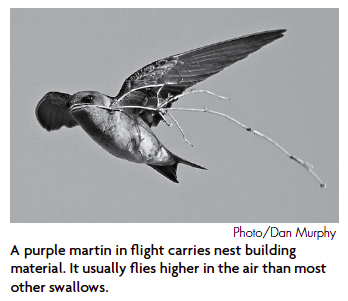The purple martin is the most intriguing bird residing in the neighborhood. It’s the largest swallow in North America and feeds in flight on insects, generally higher in the air than most other swallows. It arrives in spring from as far away as Brazil.
Though iconic of freedom, the purple martin has been driven into decline in California by human activity. It’s a “species of special concern” for the California Department of Fish and Wildlife.

The first major blow to the purple martin was the arrival of the European starling. Starlings were introduced into the United States in the 1870s by a group led by Eugene Scheieffelin, a Shakespeare fanatic, which tried to bring every bird mentioned by the bard to America. They succeeded all too well with the starling.
Unfortunately, the starling competes with native birds for nest cavities in trees and structures. The eventual spread of the starling to California in the 1960s wiped out Sacramento Valley’s purple martins, with the exception of a population in Sacramento.
Somehow our local purple martins made a cultural shift to nesting in the “weep holes” on the undersides of long bridges or overpasses. This has been the one redoubt where purple martins have been able to hold out against the starlings.
A dozen or so colony sites in Sacramento have remained in use since 1964 when the martins were first discovered using our colony site under the Sutterville Road Overpass. However, even in their Sacramento holdfast the martins are faltering, having declined approximately 80 percent since 2004.
Daniel Airola, a purple martin expert and Curtis Park alumnus, attributes the second major blow to the population to the increasing use of neonicotinoid pesticides on farms and urban landscapes. Airola believes these systemic pesticides are so successful in killing off the insect population that the martins’ limited food supply has decreased their reproductive success. Neonicotinoids have been banned in the European Union for adverse effects on pollinators, but are still permitted here.
At least four pairs of purple martins are making a go of it this year in Curtis Park. You can see them soaring and singing joyfully in the area just north of the Sutterville Road Overpass behind the new Safeway. They are hard at work gathering food to feed their young in the complex interrelated environment of our land of the free.